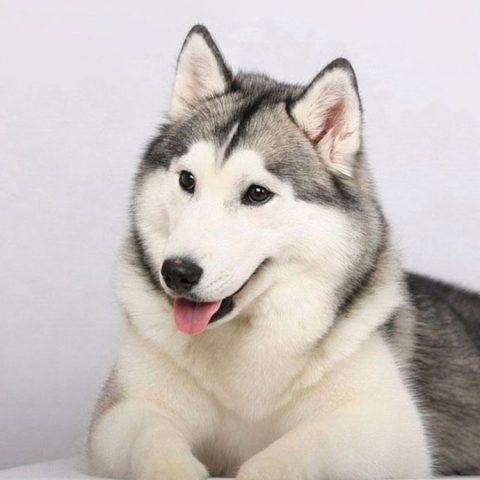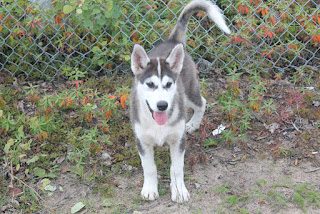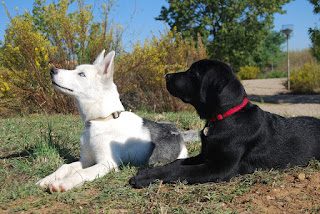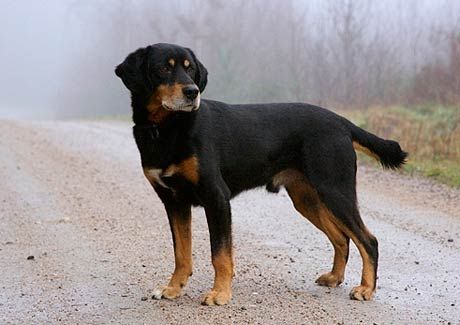Everything about your Labrador Husky

Though the name of this breed might suggest that it is a cross between the Labrador Retriever and the Siberian Husky, the Labrador Husky is actually a completely separate breed. This dog looks remarkably like a wolf, having the same double coat and wild appearance. The dog is still a largely unknown breed but if you are lucky enough to meet one you will never forget the experience.
Overview
The Labrador Husky has a similar temperament to other Northern breeds which means that they can often be unfriendly or even aggressive with strangers. However, they can be good if socialized, and they often do well with children. Being with other dogs always makes them happy, because they are bred to work well in a pack and actually many people believe they should be bought in pairs. Small animals do not usually do well with Nordic dogs but if they are raised together it should be fine. Training is easy and fun for them because they naturally learns things well. However, sometimes stubbornness will prevent them from learning silly tricks or other useless commands. Intelligence can be their gift but can be your nightmare if they are bored.
Breed standards
Dog Breed Group: Mixed Breed Dogs
Average lifespan: 10-13 years
Average size: 60 – 100 pounds
Coat appearance: Thick double coat – thick undercoat and soft outer coat
Coloration: Solid white, solid black, black and white, red and white, and grey and white
Hypoallergenic: No
Best Suited For: Families with children, active families, active singles, house with a yard
Temperament: Friendly, good-natured, intelligent, quiet
Comparable Breeds: Siberian Husky, Canadian Eskimo Dog
History
In order to best understand the history of the Labrador Husky, an explanation of the people that these dogs live alongside and serve is necessary. The Thule Inuit people developed along the coast of Alaska sometime after 200 B.C. These people migrated east across Canada, along with their dogs, and occupied the Labrador region by 1300 A.D. The Dorset people originally inhabited this region, but due in part to their lack of canine use for travel, hunting, and companionship, they were driven to extinction by the Inuit. The Inuit brought Husky dogs with them , and over time, bred these dogs with wolves to improve their strength and endurance. As these people became indigenous to the Labrador region, this breed developed independently from the aforementioned Spitz dogs, and became distinct.
The Labrador Huskies were used for transportation as sled dogs. Prior to the advent of the snowmobile, sleds were the only viable means of transportation across large swaths of land. The dogs contributed to the hunting success of the Inuit people, allowing them to travel further and hunt in a wider geographical range. In addition, the dogs helped keep their human companions warm in encampments. After the snowmobile was invented, these dogs were not needed as sled dogs, except in sled races, but have been utilised as companions and as search-and-rescue canines. In addition, due to their intelligence, they have also been used in bomb or narcotic detection.
Temperament
The Labrador Husky is an unknown and often misunderstood breed. It is not a mix between a Labrador and a Husky, but a purebred dog native of coastal Labrador. It is similar in a lot of ways to the wolf. It does not bark, but can howl like a wolf. The objective in training this dog is to achieve pack leader status. It is a natural instinct for a dog to have an order in its pack. When we humans live with dogs, we become their pack.
The entire pack cooperates under a single leader. Lines are clearly defined and rules are set. Because a dog communicates his displeasure with growling and eventually biting, all other humans MUST be higher up in the order than the dog. The humans must be the ones making the decisions, not the dogs. That is the only way your relationship with your dog can be a complete success.
Health
The Labrador Husky is fairly unknown so not much information is available about genetic disorders or their life expectancy. However, special care has been taken in their breeding which could suggest that few health problems exist.
Care
The Labrador Husky probably needs plenty of brushing as any double coated breed would. Plus, they shed once a year and during that time they should be brushed every day to make sure the loose hair gets cleaned from their coat. Exercise is, of course, essential to this sled dog. A large yard to run in and long walks will help keep them calm. However, they should also have some sort of work to do such as agility or fly ball which will keep them calm and happy.
Training
The Labrador Husky is an intelligent breed so it should respond well to training. These dogs are likely to learn quickly as long as you maintain a firm and consistent hand in training. Positive reinforcement training methods are recommended for this breed and you should keep your training sessions short and fun to ensure that your dog doesn’t lose interest and stop paying attention. Because this breed is so smart it needs plenty of mental and physical stimulation to prevent it from becoming bored and developing destructive behaviors.
Exercise
This breed needs to be taken on a daily long walk or jog. While out on the walk the dog must be made to heel beside or behind the person holding the lead, as in a dog’s mind the leader leads the way, and that leader needs to be the human.
Grooming
Labrador Huskies require extensive grooming during all parts of the year. Its extremely thick and durable coat, also known as a double coat. was made to be able to withstand harsh winters in Labrador Canada. Daily brushing is required to maintain the coat. A bath is sometimes the best way to fully groom and clean the dog. Bathing the dog does not have to be done on a regular basis, but is important in order to ensure a clean and well-groomed dog. It is also vital that the owner of a Labrador Husky checks for fleas and ticks during the warmer months.
Because this dog has such a thick coat, it is the perfect place for a tick or flea to nestle in. Not checking for these things can lead to serious problems such as Lyme disease, which can be life-threatening to the dog. The Labrador Husky sheds constantly throughout the year, so it is important to keep up with its grooming.






